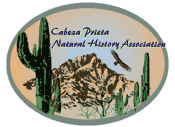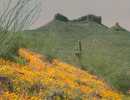
Cabeza Prieta Natural History Association
Cabeza Prieta National Wildlife Refuge History

Cabeza Prieta National Wildlife Refuge History
This refuge was created in 1939 as a "Game Range" for conservation and development of natural wildlife resources and primarily to protect the desert bighorn sheep. Located in southwestern Arizona, it is the third largest (outside Alaska) and is some 860,000 acres. In 1976 it was established as the Cabeza Prieta National Wildlife Refuge. In 1990 over 90 percent of the refuge was designated as wilderness by the Arizona Wilderness Act. Overlying the northern part of the refuge is the Barry M. Goldwater Range. This makes for a rather unusual refuge in many ways: it is extremely arid, undeveloped, quite pristine and partly under fire almost daily by the military air. Unique, yes.
The area has a rich historical and archaeological history - inhabited by the Tohono O'odham and Sand Papago, travelled over by Father Kino in the late 1600's and in the 1800's gold seekers on their way to rich California. There are a lot of ghosts on the infamous El Camino del Diablo which crosses the refuge and stretches from Mexico to California.
Indigenous hunters were the earliest inhabitants some 10,000 years ago and the area was cooler, wetter and had more vegetation. Climatic changes over the centuries created a land similar to what we see today. Hunting, gathering nomadic people processed plants on grinding stones, protected themselves in the many small caves, and reaped the foods of the desert: cactus fruit, mesquite beans, small game and the bighorn sheep.
During the early and middle part of the 20th Century, grazing and mining were common in the area that would later become the Cabeza Prieta Refuge. Conditions were harsh for either occupation - temperatures up to 115 in the summer, lack of water, deluges of rain during the summer monsoons, blowing dust, flash floods and drought. What was a dusty, dry fairly usable trail or road could turn in a matter of hours to an impassable slog of mud or rampant water washing away equipment, animals and people.
In 1941 the Refuge was included in a large tract of public land set aside and designated as the Williams Bombing and Gunnery Range (later Goldwater). It was used then in air-to-air and air-to-ground practice and is still used today. It is the second largest range in the Dept. of Defense, and the busiest. For this reason a permit is necessary to go on the Refuge and designated areas are off limits. The DOD lends its cooperation to the Refuge in many, many ways and causes minimal impact to the desert. It is a fascinating air show on some days to hear and see the big jets swooping, turning and passing so close overhead you can wave at the pilots.
In recent years, not only the bighorn sheep, but the fragile Sonoran pronghorn antelope are part of the protection plan. Water, always a scarce commodity in the desert, continues to be a problem especially in these drought years. The natural catchments (tinajas) used since prehistory are still a precious part of the landscape and some improvements have been made with water tanks and enlarging catchments.
The other major impact on this refuge and the neighboring Organ Pipe National Monument is the "border" issue: tens of thousands of undocumented aliens coming north for work in the U.S. coupled with the cartel drug trade which continues to find innovative and ingenious ways to transport thousands of pounds of illegal drugs across this vast, uninhabited border.
Funds allocated for the conservation and protection of the Refuge go instead to law enforcement, road maintenance, abandoned cars, trash and human waste management from passers-through, search and rescue, deaths, medical care, stolen cars and high speed chase fallout. All this impacting the animals, fragile landscape, bird, bat and reptile populations: an environmental and biological chain reaction not for the better.
The area is rich in Sonoran plants, small critters and reptiles, birds and simply gorgeous scenery. Bats, owls, snakes, lizards, coyotes, foxes, javelina, hummingbirds, tortoises, sheep, deer - by air, in caves, in burrows, under rocks, on top of mountains. Stop, be quiet, wait until sunset by a well or charco. Leave no trace.
Recreation by the public is permitted on the refuge - there is plenty of space NOT under fire! Visitors must register and are restricted to certain areas, to four wheel drive vehicles, and to other rules designed to protect the resources (and the visitors!).
Oh yes, Cabeza Prieta means "dark head" - referring to a lava topped peak on one of the mountain ranges. And: Tinaja - natural rock tanks or pot holes in stream stems, some improved and may hold water year round; Charcos - natural basins that may hold water for a few months; Playas - may hold water for a few days after a heavy rain.
Cabeza Prieta National Wildlife Refuge Facts
Cabeza Prieta National Wildlife Refuge Location
Copyright Creative Commons
HTML & Programing by
Thomas R. Powell